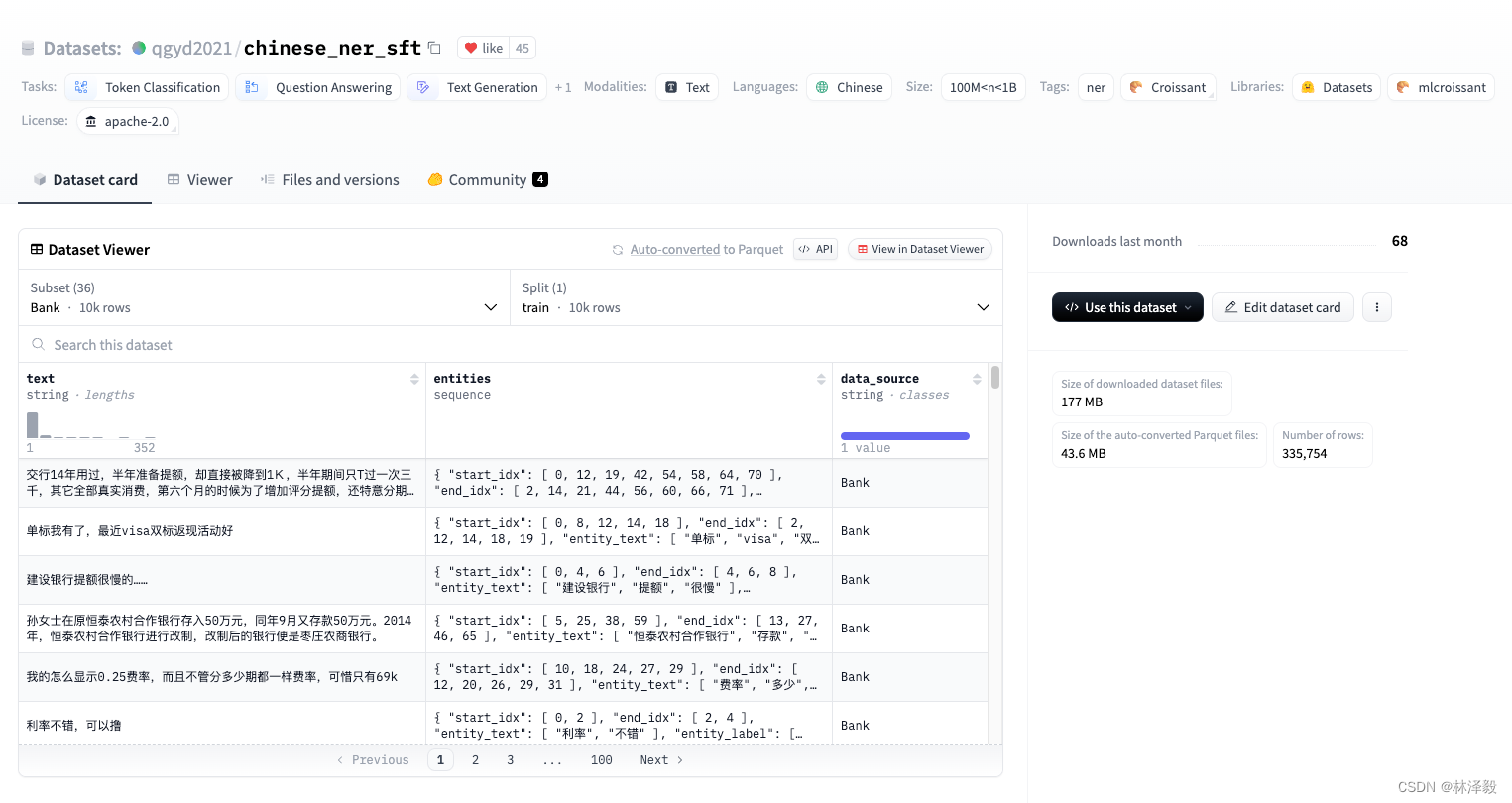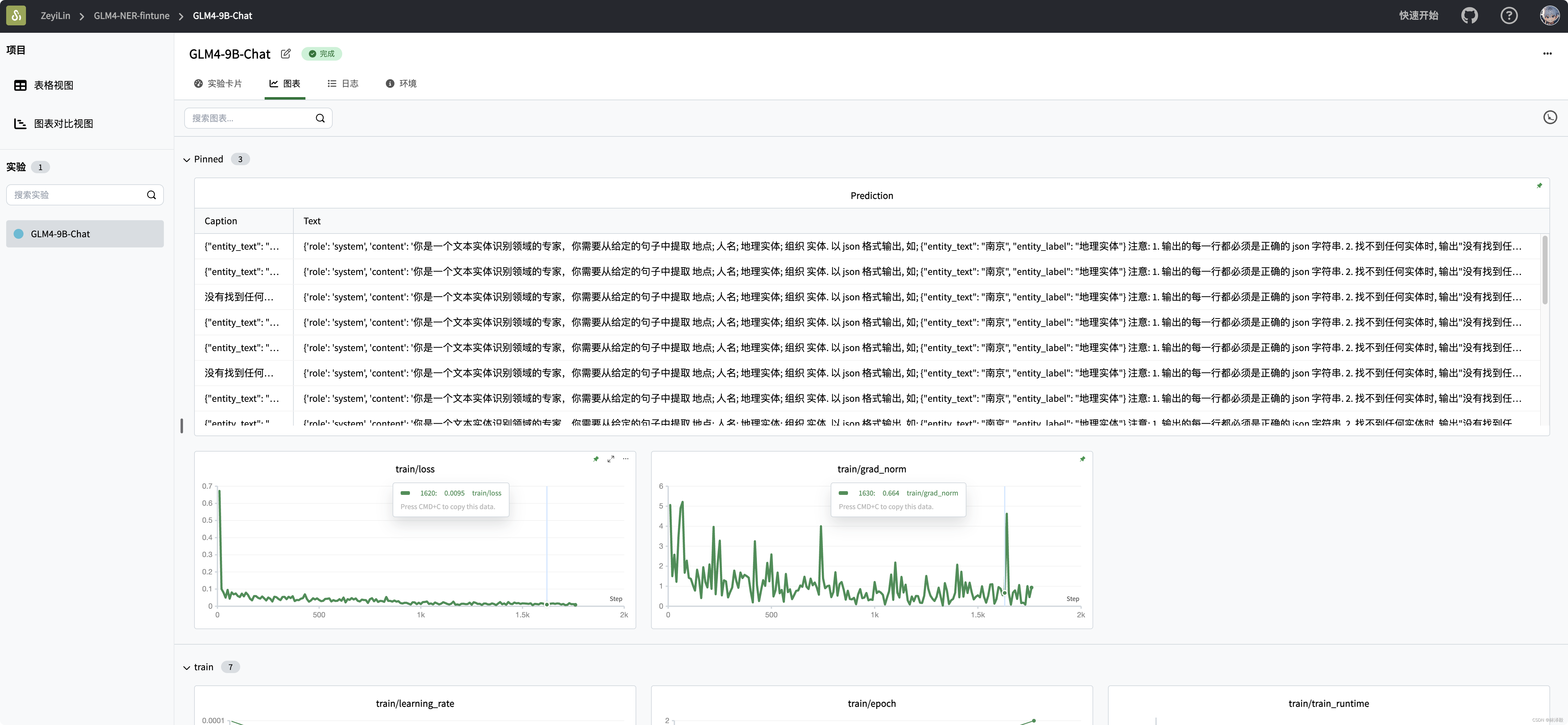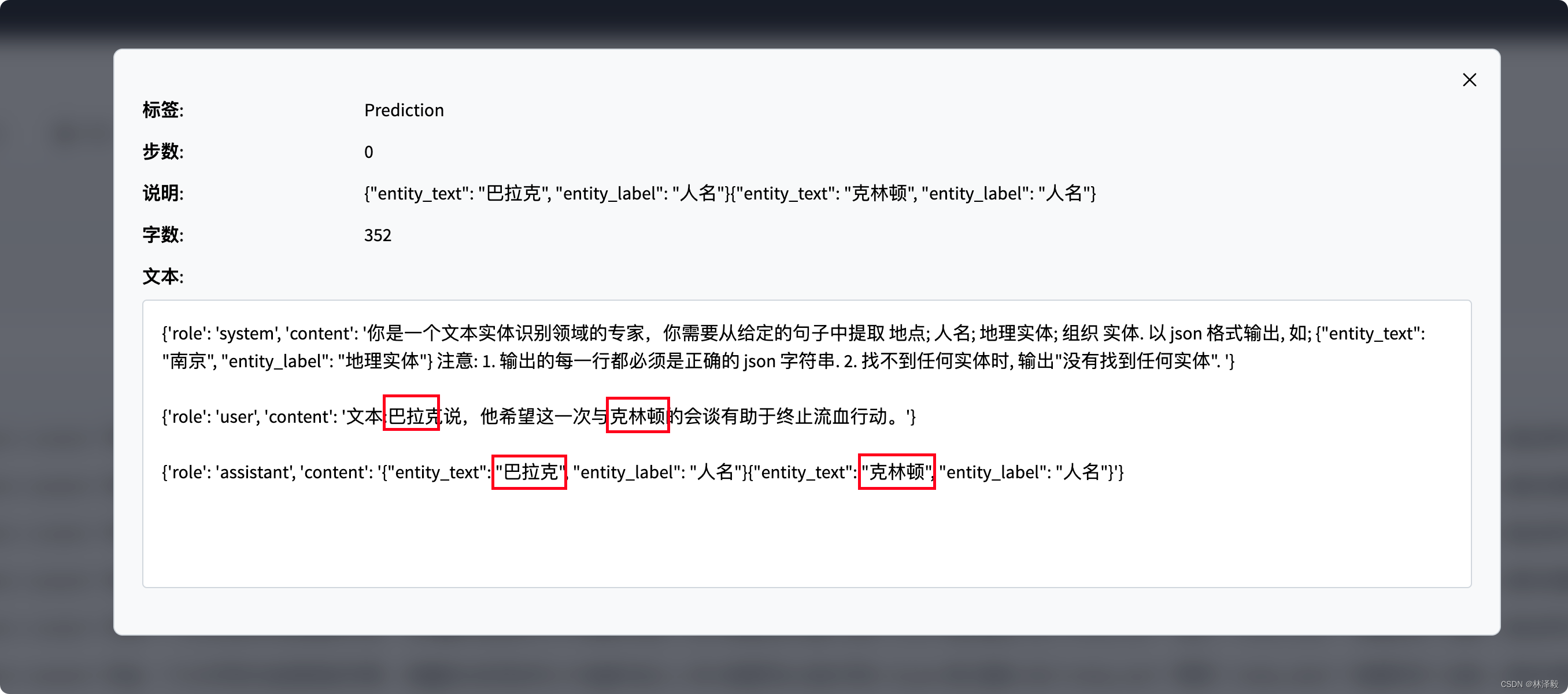- 1编程语言命名规范_请结合所学以及网络资料,介绍一下编程语言有哪些命名规则
- 2linux安装redis超级详细教程_linux环境部署redis6.2.10
- 3推动内容安全生态与通用大模型良性融合_内容安全通过大模型解决
- 4Linux : 解决ssh命令失败(ssh: Network is unreachable),MobaXtermSSH连接超时(Network error:Conection timed out )_ssh network is unreachable
- 5分布式系统—ELK日志分析系统概述及部署
- 6mysql添加用户_mysql添加用户
- 7C语言写二叉树_建立二叉树的代码c语言
- 8超详细的VSCode下载和安装教程(非常详细)从零基础入门到精通,看完这一篇就够了。
- 9PyCharm查看运行状态的步骤及方式!_pycharm 运行进度
- 10等保系列之——网络安全等级保护测评:工作流程及工作内容_网络安全等级保护测评流程
GLM4大模型微调入门实战-命名实体识别(NER)任务_glm4 sft
赞
踩
GLM4是清华智谱团队最近开源的大语言模型。
以GLM4作为基座大模型,通过指令微调的方式做高精度的命名实体识别(NER),是学习入门LLM微调、建立大模型认知的非常好的任务。

显存要求相对较高,需要40GB左右。
在本文中,我们会使用 GLM4-9b-Chat 模型在 中文NER 数据集上做指令微调训练,同时使用SwanLab监控训练过程、评估模型效果。
- 代码:完整代码直接看本文第6节 或 Github
- 实验日志过程:GLM4-NER-Fintune - SwanLab
- 模型:Modelscope
- 数据集:chinese_ner_sft
- SwanLab:https://swanlab.cn
知识点1:什么是指令微调?
大模型指令微调(Instruction Tuning)是一种针对大型预训练语言模型的微调技术,其核心目的是增强模型理解和执行特定指令的能力,使模型能够根据用户提供的自然语言指令准确、恰当地生成相应的输出或执行相关任务。
指令微调特别关注于提升模型在遵循指令方面的一致性和准确性,从而拓宽模型在各种应用场景中的泛化能力和实用性。
在实际应用中,我的理解是,指令微调更多把LLM看作一个更智能、更强大的传统NLP模型(比如Bert),来实现更高精度的NLP任务。所以这类任务的应用场景覆盖了以往NLP模型的场景,甚至很多团队拿它来标注互联网数据。
知识点2:什么是命名实体识别?
命名实体识别 (NER) 是一种NLP技术,主要用于识别和分类文本中提到的重要信息(关键词)。这些实体可以是人名、地名、机构名、日期、时间、货币值等等。 NER 的目标是将文本中的非结构化信息转换为结构化信息,以便计算机能够更容易地理解和处理。

NER 也是一项非常实用的技术,包括在互联网数据标注、搜索引擎、推荐系统、知识图谱、医疗保健等诸多领域有广泛应用。
1.环境安装
本案例基于Python>=3.8,请在您的计算机上安装好Python,并且有一张英伟达显卡(显存要求并不高,大概10GB左右就可以跑)。
我们需要安装以下这几个Python库,在这之前,请确保你的环境内已安装好了pytorch以及CUDA:
swanlab
modelscope
transformers
datasets
peft
accelerate
pandas
tiktoken
- 1
- 2
- 3
- 4
- 5
- 6
- 7
- 8
一键安装命令:
pip install swanlab modelscope transformers datasets peft pandas accelerate tiktoken
- 1
本案例测试于modelscope1.14.0、transformers4.41.2、datasets2.18.0、peft0.11.1、accelerate0.30.1、swanlab0.3.11、tiktoken==0.7.0
2.准备数据集
本案例使用的是HuggingFace上的chinese_ner_sft数据集,该数据集主要被用于训练命名实体识别模型。

chinese_ner_sft由不同来源、不同类型的几十万条数据组成,应该是我见过收录最齐全的中文NER数据集。
这次训练我们不需要用到它的全部数据,只取其中的CCFBDCI数据集(中文命名实体识别算法鲁棒性评测数据集)进行训练,该数据集包含LOC(地点)、GPE(地理)、ORG(组织)和PER(人名)四种实体类型标注,每条数据的例子如下:
{ "text": "今天亚太经合组织第十二届部长级会议在这里开幕,中国外交部部长唐家璇、外经贸部部长石广生出席了会议。", "entities": [ { "start_idx": 23, "end_idx": 25, "entity_text": "中国", "entity_label": "GPE", "entity_names": ["地缘政治实体", "政治实体", "地理实体", "社会实体"]}, { "start_idx": 25, "end_idx": 28, "entity_text": "外交部", "entity_label": "ORG", "entity_names": ["组织", "团体", "机构"] }, { "start_idx": 30, "end_idx": 33, "entity_text": "唐家璇", "entity_label": "PER", "entity_names": ["人名", "姓名"] }, ... ], "data_source": "CCFBDCI" }
- 1
- 2
- 3
- 4
- 5
- 6
- 7
- 8
- 9
- 10
- 11
- 12
- 13
- 14
- 15
- 16
- 17
- 18
- 19
- 20
- 21
- 22
- 23
- 24
- 25
- 26
- 27
其中text是输入的文本,entities是文本抽取出的实体。我们的目标是希望微调后的大模型能够根据由text组成的提示词,预测出一个json格式的实体信息:
输入:今天亚太经合组织第十二届部长级会议在这里开幕,中国外交部部长唐家璇、外经贸部部长石广生出席了会议。
大模型输出:{"entity_text":"中国", "entity_label":"组织"}{"entity_text":"唐家璇", "entity_label":"人名"}...
- 1
- 2
- 3
现在我们将数据集下载到本地目录。下载方式是前往chinese_ner_sft - huggingface下载ccfbdci.jsonl到项目根目录下即可:

3. 加载模型
这里我们使用modelscope下载GLM4-9b-Chat模型(modelscope在国内,所以直接用下面的代码自动下载即可,不用担心速度和稳定性问题),然后把它加载到Transformers中进行训练:
from modelscope import snapshot_download, AutoTokenizer
from transformers import AutoModelForCausalLM, TrainingArguments, Trainer, DataCollatorForSeq2Seq
import torch
model_id = "ZhipuAI/glm-4-9b-chat"
model_dir = "./ZhipuAI/glm-4-9b-chat/"
# 在modelscope上下载GLM4模型到本地目录下
model_dir = snapshot_download(model_id, cache_dir="./", revision="master")
# Transformers加载模型权重
tokenizer = AutoTokenizer.from_pretrained(model_dir, use_fast=False, trust_remote_code=True)
model = AutoModelForCausalLM.from_pretrained(model_dir, device_map="auto", torch_dtype=torch.bfloat16, trust_remote_code=True)
model.enable_input_require_grads() # 开启梯度检查点时,要执行该方法
- 1
- 2
- 3
- 4
- 5
- 6
- 7
- 8
- 9
- 10
- 11
- 12
- 13
- 14
4. 配置LoRA
from peft import LoraConfig, TaskType, get_peft_model
config = LoraConfig(
task_type=TaskType.CAUSAL_LM,
target_modules=["query_key_value", "dense", "dense_h_to_4h", "activation_func", "dense_4h_to_h"],
inference_mode=False, # 训练模式
r=8, # Lora 秩
lora_alpha=32, # Lora alaph,具体作用参见 Lora 原理
lora_dropout=0.1, # Dropout 比例
)
model = get_peft_model(model, config)
- 1
- 2
- 3
- 4
- 5
- 6
- 7
- 8
- 9
- 10
- 11
- 12
5. 配置训练可视化工具
我们使用SwanLab来监控整个训练过程,并评估最终的模型效果。
这里直接使用SwanLab和Transformers的集成来实现:
from swanlab.integration.huggingface import SwanLabCallback
swanlab_callback = SwanLabCallback(...)
trainer = Trainer(
...
callbacks=[swanlab_callback],
)
- 1
- 2
- 3
- 4
- 5
- 6
- 7
- 8
- 9
如果你是第一次使用SwanLab,那么还需要去https://swanlab.cn上注册一个账号,在用户设置页面复制你的API Key,然后在训练开始时粘贴进去即可:

6. 完整代码
开始训练时的目录结构:
|--- train.py
|--- ccfbdci.jsonl
- 1
- 2
train.py:
import json import pandas as pd import torch from datasets import Dataset from modelscope import snapshot_download, AutoTokenizer from swanlab.integration.huggingface import SwanLabCallback from peft import LoraConfig, TaskType, get_peft_model from transformers import AutoModelForCausalLM, TrainingArguments, Trainer, DataCollatorForSeq2Seq import os import swanlab def dataset_jsonl_transfer(origin_path, new_path): """ 将原始数据集转换为大模型微调所需数据格式的新数据集 """ messages = [] # 读取旧的JSONL文件 with open(origin_path, "r") as file: for line in file: # 解析每一行的json数据 data = json.loads(line) input_text = data["text"] entities = data["entities"] match_names = ["地点", "人名", "地理实体", "组织"] entity_sentence = "" for entity in entities: entity_json = dict(entity) entity_text = entity_json["entity_text"] entity_names = entity_json["entity_names"] for name in entity_names: if name in match_names: entity_label = name break entity_sentence += f"""{{"entity_text": "{entity_text}", "entity_label": "{entity_label}"}}""" if entity_sentence == "": entity_sentence = "没有找到任何实体" message = { "instruction": """你是一个文本实体识别领域的专家,你需要从给定的句子中提取 地点; 人名; 地理实体; 组织 实体. 以 json 格式输出, 如 {"entity_text": "南京", "entity_label": "地理实体"} 注意: 1. 输出的每一行都必须是正确的 json 字符串. 2. 找不到任何实体时, 输出"没有找到任何实体". """, "input": f"文本:{input_text}", "output": entity_sentence, } messages.append(message) # 保存重构后的JSONL文件 with open(new_path, "w", encoding="utf-8") as file: for message in messages: file.write(json.dumps(message, ensure_ascii=False) + "\n") def process_func(example): """ 对数据集进行数据预处理,主要用于被dataset.map调用 """ MAX_LENGTH = 384 input_ids, attention_mask, labels = [], [], [] system_prompt = """你是一个文本实体识别领域的专家,你需要从给定的句子中提取 地点; 人名; 地理实体; 组织 实体. 以 json 格式输出, 如 {"entity_text": "南京", "entity_label": "地理实体"} 注意: 1. 输出的每一行都必须是正确的 json 字符串. 2. 找不到任何实体时, 输出"没有找到任何实体".""" instruction = tokenizer( f"<|system|>\n{system_prompt}<|endoftext|>\n<|user|>\n{example['input']}<|endoftext|>\n<|assistant|>\n", add_special_tokens=False, ) response = tokenizer(f"{example['output']}", add_special_tokens=False) input_ids = instruction["input_ids"] + response["input_ids"] + [tokenizer.pad_token_id] attention_mask = ( instruction["attention_mask"] + response["attention_mask"] + [1] ) labels = [-100] * len(instruction["input_ids"]) + response["input_ids"] + [tokenizer.pad_token_id] if len(input_ids) > MAX_LENGTH: # 做一个截断 input_ids = input_ids[:MAX_LENGTH] attention_mask = attention_mask[:MAX_LENGTH] labels = labels[:MAX_LENGTH] return {"input_ids": input_ids, "attention_mask": attention_mask, "labels": labels} def predict(messages, model, tokenizer): """对测试集进行模型推理,得到预测结果""" device = "cuda" text = tokenizer.apply_chat_template( messages, tokenize=False, add_generation_prompt=True ) model_inputs = tokenizer([text], return_tensors="pt").to(device) generated_ids = model.generate( model_inputs.input_ids, max_new_tokens=512 ) generated_ids = [ output_ids[len(input_ids):] for input_ids, output_ids in zip(model_inputs.input_ids, generated_ids) ] response = tokenizer.batch_decode(generated_ids, skip_special_tokens=True)[0] print(response) return response model_id = "ZhipuAI/glm-4-9b-chat" model_dir = "./ZhipuAI/glm-4-9b-chat/" # 在modelscope上下载GLM4模型到本地目录下 model_dir = snapshot_download(model_id, cache_dir="./", revision="master") # Transformers加载模型权重 tokenizer = AutoTokenizer.from_pretrained(model_dir, use_fast=False, trust_remote_code=True) model = AutoModelForCausalLM.from_pretrained(model_dir, device_map="auto", torch_dtype=torch.bfloat16, trust_remote_code=True) model.enable_input_require_grads() # 开启梯度检查点时,要执行该方法 # 加载、处理数据集和测试集 train_dataset_path = "ccfbdci.jsonl" train_jsonl_new_path = "ccf_train.jsonl" if not os.path.exists(train_jsonl_new_path): dataset_jsonl_transfer(train_dataset_path, train_jsonl_new_path) # 得到训练集 total_df = pd.read_json(train_jsonl_new_path, lines=True) train_df = total_df[int(len(total_df) * 0.1):] train_ds = Dataset.from_pandas(train_df) train_dataset = train_ds.map(process_func, remove_columns=train_ds.column_names) # 配置LoRA config = LoraConfig( task_type=TaskType.CAUSAL_LM, target_modules=["query_key_value", "dense", "dense_h_to_4h", "activation_func", "dense_4h_to_h"], inference_mode=False, # 训练模式 r=8, # Lora 秩 lora_alpha=32, # Lora alaph,具体作用参见 Lora 原理 lora_dropout=0.1, # Dropout 比例 ) # 得到被peft包装后的模型 model = get_peft_model(model, config) # 配置Transformers训练参数 args = TrainingArguments( output_dir="./output/GLM4-NER", per_device_train_batch_size=4, per_device_eval_batch_size=4, gradient_accumulation_steps=4, logging_steps=10, num_train_epochs=2, save_steps=100, learning_rate=1e-4, save_on_each_node=True, gradient_checkpointing=True, report_to="none", ) # 设置SwanLab与Transformers的回调 swanlab_callback = SwanLabCallback( project="GLM4-NER-fintune", experiment_name="GLM4-9B-Chat", description="使用智谱GLM4-9B-Chat模型在NER数据集上微调,实现关键实体识别任务。", config={ "model": model_id, "model_dir": model_dir, "dataset": "qgyd2021/chinese_ner_sft", }, ) # 设置Transformers Trainer trainer = Trainer( model=model, args=args, train_dataset=train_dataset, data_collator=DataCollatorForSeq2Seq(tokenizer=tokenizer, padding=True), callbacks=[swanlab_callback], ) # 开始训练 trainer.train() # 用随机20条数据测试模型 test_df = total_df[:int(len(total_df) * 0.1)].sample(n=20) test_text_list = [] for index, row in test_df.iterrows(): instruction = row['instruction'] input_value = row['input'] messages = [ {"role": "system", "content": f"{instruction}"}, {"role": "user", "content": f"{input_value}"} ] response = predict(messages, model, tokenizer) messages.append({"role": "assistant", "content": f"{response}"}) result_text = f"{messages[0]}\n\n{messages[1]}\n\n{messages[2]}" test_text_list.append(swanlab.Text(result_text, caption=response)) # 记录测试结果 swanlab.log({"Prediction": test_text_list}) # 关闭SwanLab记录 swanlab.finish()
- 1
- 2
- 3
- 4
- 5
- 6
- 7
- 8
- 9
- 10
- 11
- 12
- 13
- 14
- 15
- 16
- 17
- 18
- 19
- 20
- 21
- 22
- 23
- 24
- 25
- 26
- 27
- 28
- 29
- 30
- 31
- 32
- 33
- 34
- 35
- 36
- 37
- 38
- 39
- 40
- 41
- 42
- 43
- 44
- 45
- 46
- 47
- 48
- 49
- 50
- 51
- 52
- 53
- 54
- 55
- 56
- 57
- 58
- 59
- 60
- 61
- 62
- 63
- 64
- 65
- 66
- 67
- 68
- 69
- 70
- 71
- 72
- 73
- 74
- 75
- 76
- 77
- 78
- 79
- 80
- 81
- 82
- 83
- 84
- 85
- 86
- 87
- 88
- 89
- 90
- 91
- 92
- 93
- 94
- 95
- 96
- 97
- 98
- 99
- 100
- 101
- 102
- 103
- 104
- 105
- 106
- 107
- 108
- 109
- 110
- 111
- 112
- 113
- 114
- 115
- 116
- 117
- 118
- 119
- 120
- 121
- 122
- 123
- 124
- 125
- 126
- 127
- 128
- 129
- 130
- 131
- 132
- 133
- 134
- 135
- 136
- 137
- 138
- 139
- 140
- 141
- 142
- 143
- 144
- 145
- 146
- 147
- 148
- 149
- 150
- 151
- 152
- 153
- 154
- 155
- 156
- 157
- 158
- 159
- 160
- 161
- 162
- 163
- 164
- 165
- 166
- 167
- 168
- 169
- 170
- 171
- 172
- 173
- 174
- 175
- 176
- 177
- 178
- 179
- 180
- 181
- 182
- 183
- 184
- 185
- 186
- 187
- 188
- 189
- 190
- 191
- 192
- 193
- 194
- 195
- 196
- 197
- 198
- 199
- 200
- 201
- 202
- 203
- 204
- 205
看到下面的进度条即代表训练开始:

7.训练结果演示
在SwanLab上查看最终的训练结果:
可以看到在2个epoch之后,微调后的GLM4的loss降低到了不错的水平——当然对于大模型来说,真正的效果评估还得看主观效果。

可以看到在一些测试样例上,微调后的GLM4能够给出准确的NER结果:

至此,你已经完成了qwen2指令微调的训练!
8.推理训练好的模型
训好的模型默认被保存在./output/GLM4-NER文件夹下。
推理模型的代码如下:
import torch from transformers import AutoModelForCausalLM, AutoTokenizer from peft import PeftModel def predict(messages, model, tokenizer): device = "cuda" text = tokenizer.apply_chat_template(messages, tokenize=False, add_generation_prompt=True) model_inputs = tokenizer([text], return_tensors="pt").to(device) generated_ids = model.generate(model_inputs.input_ids, max_new_tokens=512) generated_ids = [output_ids[len(input_ids):] for input_ids, output_ids in zip(model_inputs.input_ids, generated_ids)] response = tokenizer.batch_decode(generated_ids, skip_special_tokens=True)[0] return response model_dir = "./ZhipuAI/glm-4-9b-chat/" lora_dir = "./output/GLM4-NER/checkpoint-1700" # 加载原下载路径的tokenizer和model tokenizer = AutoTokenizer.from_pretrained(model_dir, use_fast=False, trust_remote_code=True) model = AutoModelForCausalLM.from_pretrained(model_dir, device_map="auto", torch_dtype=torch.bfloat16) # 加载训练好的Lora模型 model = PeftModel.from_pretrained(model, model_id=lora_dir) input_text = "西安电子科技大学的陈志明爱上了隔壁西北工业大学苏春红,他们约定好毕业后去中国的苏州定居。" test_texts = { "instruction": """你是一个文本实体识别领域的专家,你需要从给定的句子中提取 地点; 人名; 地理实体; 组织 实体. 以 json 格式输出, 如; {"entity_text": "南京", "entity_label": "地理实体"} 注意: 1. 输出的每一行都必须是正确的 json 字符串. 2. 找不到任何实体时, 输出"没有找到任何实体". """, "input": f"文本:{input_text}" } instruction = test_texts['instruction'] input_value = test_texts['input'] messages = [ {"role": "system", "content": f"{instruction}"}, {"role": "user", "content": f"{input_value}"} ] response = predict(messages, model, tokenizer) print(response)
- 1
- 2
- 3
- 4
- 5
- 6
- 7
- 8
- 9
- 10
- 11
- 12
- 13
- 14
- 15
- 16
- 17
- 18
- 19
- 20
- 21
- 22
- 23
- 24
- 25
- 26
- 27
- 28
- 29
- 30
- 31
- 32
- 33
- 34
- 35
- 36
- 37
- 38
- 39
- 40
- 41
- 42
输出结果为:
{"entity_text": "西安电子科技大学", "entity_label": "组织"}
{"entity_text": "陈志明", "entity_label": "人名"}
{"entity_text": "西北工业大学", "entity_label": "组织"}
{"entity_text": "苏春红", "entity_label": "人名"}
{"entity_text": "中国", "entity_label": "地理实体"}
{"entity_text": "苏州", "entity_label": "地理实体"}
- 1
- 2
- 3
- 4
- 5
- 6
相关链接
- 代码:完整代码直接看本文第6节 或 Github
- 实验日志过程:GLM4-NER-Fintune - SwanLab
- 模型:Modelscope
- 数据集:chinese_ner_sft
- SwanLab:https://swanlab.cn



